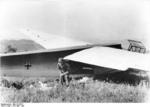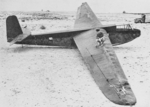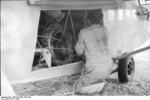DFS 230
| Country | Germany |
| Manufacturer | Deutsche Forschungsanstalt für Segelflug |
| Primary Role | Glider |
Contributor: C. Peter Chen
ww2dbaseThe DFS 230 gliders were manufactured by the German Research Institute for Sailplane Flight, a state-run organization established in 1933 to train future German pilots under the guise of recreational gliding. The design was completed in 1937. These gliders were first introduced into military service in 1938. They could carry 10 equipped soldiers, or a payload of about 1,200 kilograms. Over 1,600 examples were built. They were used in several high-profile operations, including the assault on Fort Eben-Emael in Belgium, the airborne invasion of Crete in Greece, and the rescue of Benito Mussolini in Italy.
ww2dbaseSource: Wikipedia.
Last Major Revision: Oct 2010
SPECIFICATIONS
DFS 230
| Armament | 1x7.92mm MG 34 machine gun, capacity for 10 soldiers or 1,240kg of cargo |
| Crew | 1 |
| Span | 21.10 m |
| Length | 11.30 m |
| Height | 2.80 m |
| Wing Area | 38.10 m² |
| Weight, Empty | 770 kg |
| Weight, Loaded | 2,040 kg |
| Weight, Maximum | 2,100 kg |
| Speed, Maximum | 161 km/h |
Photographs
 |  |  |  |
Please consider supporting us on Patreon. Even $1 per month will go a long way! Thank you. Please help us spread the word: Stay updated with WW2DB: |
Visitor Submitted Comments
7 Dec 2010 06:20:17 PM
Another DFS project was the DFS-228 rocket plane. This aircraft was designed as a single-seat rocket-powered, high altitude reconnaissance aircraft.
YEARS AHEAD OF ITS TIME:
By the end of the war two aircraft were built
one was destroyed in a Allied air raid, the
other was captured by US troops.
In 1946 the second prototype was shipped to
England for study, by both American and
British engineers.
After its design study,the DFS-228 was later scrapped in 1947.
Before the war, ended the DFS-228 prototype had flown unpowered. The DFS-228 would have been powered by One Walter HWK Rocket motor, its estimated speed was about 900km/h or 560 mph. Service ceiling was 25,000 meters or 82,000 feet, range was 1,050 km or 655 miles
The DFS-228 was carried piggy back style, a Dornier Do 217 bomber was used as the launch aircraft. The tests were unpowered and used for flight testing only.
This concept was years ahead of the future
American Space Program tests of the
Boeing 747/Space Shuttle test flights.
POST-WAR:
Post-war developments in ultra high-altitude
reconnaissance aircraft, that followed were the American Lockheed U-2 & SR-71 Blackbird.
26 Feb 2011 05:10:03 AM
Some 20 years ago I used to own a series of ROC magazines from the immediate post-war period. In the letters page of one of these was a decription of the Farnborough DFS228 in its original paint scheme of gloss cream.
18 May 2014 05:18:04 AM
Various accounts give contradictory numbers of men in Assault Group GRANITE led by Oberleutnant Witzig which assailed Fort Eben Emael. The group was to be carried in eleven DFS230 gliders and nine of these successfully landed on the fort's flat roof. Given that space would have been needed to carry their hollow charge explosives, flame throwers and other equipment it would seem unlikely that the gliders actually carried their full complimemt of nine infantrymen plus pilot. The attackers were all trained and experienced combat engineers, and were equipped with 50-kg hollow charge explosives capable of punching a hole 30cm in diameter through two metres of concrete. This was the first recorded use of hollow charge weapons in warfare. The Belgian garrison of the fort amounted to about 750 men although they had not been trained in infantry tactics. The explosives detonated on top of the emplacements and turrets blew holes through the armour and concrete, sending a jet of flame and molten metal into the turret structure to wreck internal machinery and kill or shock the defenders. Those who survived were assailed by flame-throwers or small charges and grenades dropped through the holes. Blasting open steel doors, the German paratroopers entered the fort and, once inside, were difficult to eject as the defenders had to attack up 60 ft of spiral staircase. In a few hours, at a cost of six dead and twenty wounded, Oberleutnant Witzig's men had neutralised Eben Emael, and it is claimed that only after the highly secretive operation (two men were sentenced to death for minor infringements during training) was over that the men learned the names of their companions.
29 Jul 2022 03:01:48 AM
Does anyone know where the DFS pilots were trained?
I am trying to piece together my Luftwaffe father's past and it looks like he might have flown the DFS and later transferred to Bat.2 Rgmt3 Fallschrimjager. Any info would be fantastic! Thanks Eileen
All visitor submitted comments are opinions of those making the submissions and do not reflect views of WW2DB.
» Operation Eiche
- » 1,167 biographies
- » 337 events
- » 44,601 timeline entries
- » 1,243 ships
- » 350 aircraft models
- » 207 vehicle models
- » 376 weapon models
- » 123 historical documents
- » 261 facilities
- » 470 book reviews
- » 28,504 photos
- » 366 maps
Winston Churchill, 1935
Please consider supporting us on Patreon. Even $1 a month will go a long way. Thank you!
Or, please support us by purchasing some WW2DB merchandise at TeeSpring, Thank you!
1 Dec 2010 09:23:54 AM
Deutsche Forschungsanstitut Fur Segelflug DFS
or, German Research Institute For Sailplane Flight.
Established in 1925 the Institute designed and built successful gliders. In 1933 it was
centralized for all gliding activity in
Germany.
The institute also worked on various projects
involving jet propulsion, swept-wing and
delta-wing aircraft designs pioneered by
Dr. Dr.Alexander Lippisch.
The DFS 230 assault glider was designed for
paratroop operations. The glider could carry
ten troops, its first flight was in 1937.
The glider was towed by a Junkers Ju 52 which
flew empty, and could tow as many as three of
the gliders. The DFS 230 was 38 feet long, and had a wingspan of 72 feet about 455 were
built.
Other aircraft were used as tow planes such
as the Messerschmitt Bf 110. The first use
of the DFS 230, was during the invasion of
Belgium May 10, 1940.
In the early morning hours, Ten gliders carring seventy eight troops landed on top of Fort Eben Emael this position was a barrier to the invasion of Belgium & Holland
The garrison of 800 men was defended by Machineguns, Minefields and Artillery, the roof was 1,000 yards long and 800 yards wide
enough for the gliders to land.
The fort was taken, the Germans lost six men
and twenty wounded.